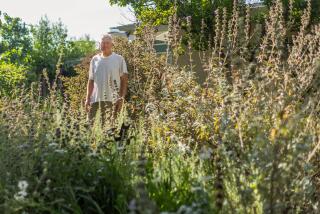Caribbean Colors
You won’t find roses above Eric Nagelmann’s front door in his Santa Barbara garden. The garden designer has gone a nontraditional route, planting yellow stigmaphyllon vine, its leaves and blooms packed so densely among fuchsias and staghorn ferns that the house itself, fully wreathed, seems alive. Nearby, maidenhair ferns and polypodiums sprout with kalanchoes and orange impatiens. “Poor plant, it’s had a bad rap. But you should see impatiens in the Costa Rican rain forest,” says Nagelmann, who is known for charging even formal landscapes with dreamy, unexpected details. Lotus ponds. Black fishtail palms. “The magic comes with how you use the plant.”
In his own garden, on a narrow, 50-by-100-foot slope above the Santa Barbara harbor, there were few plants when he arrived in 1998. Wall-to-wall concrete and chain-link set the scene around the boxy, late-’60s era house. But to a designer, emptiness equals opportunity. Once Nagelmann moved in he began stripping down the house, removing carpets, chandeliers and tatty wallpaper, painting the indoors white. Outside, he chose gunmetal green for walls that he would swath in leaves, then added a pink front door, what he calls “shades of the Caribbean.” After jackhammering the cement, and uncovering hard-packed clay soil, he brought in truckloads of compost, sand and gypsum and spent days digging into the ground.
Then came the fun part: choosing the exotic palette. “I knew I wanted big-leaved ficus, schizolobium and cussonia,” he says, naming trees which, along with some favorite palms, would evoke the spirit of the tropics. He added logical shade companions such as fuchsias, coleus, hydrangeas, crinum lilies. On the lower hill, which gets direct sunlight, he planted most of his succulents, a class of plants he has collected since he started gardening as a child. In other spots, light- and shade-lovers grow together, in the dappled shadows of a path, for instance, where bougainvillea twines above crassula and graptopetalum and Spanish moss drips from coral trees. “I can mix these because I hand-water everything,” he says, describing the garden as “a fantasy based on contrasts. What’s alien is interesting--those elements that don’t belong and that make you suddenly look twice.”
Among the aliens are some Arizona junipers feathering up from a stand of palms. Or the colorful marigolds he tucked in last year among his succulents. Tomatoes hidden by euphorbias. “Humor is important too,” Nagelmann says. “We should have fun with our gardens, and not make them all about show.”
The designer also makes room for new, or old, plant passions: the ivy geranium, say, that reminds Nagelmann of his childhood. The Puya alpestris, a blue-green succulent with otherworldly orange blooms. “I’m not into ‘pretty,’ ” he says. “I look for plants that touch my emotions or challenge my perceptions. To me, this is what life’s about. Being open to seeing things with fresh eyes.”
He is open to editing, too, as plants grow and crowd or shade out other plants. Two years ago, sweet peas raged up one of his fences. Last year, given the density of trees, he didn’t bother to replant them. And he has fewer bananas than he once did, and one lemon tree instead of two. Still, it’s not as easy as it was to see his ocean view, or even to see across the lot.
Nagelmann loves highly textural combinations--furcraea spiking among banana leaves, opuntia popping up behind cycads, poppies blooming in their midst. If you ask him where he’s going with these, he laughs. “I’m pretty spontaneous,” he says. “I mostly listen to my instincts. But, a true garden is never finished. And I’m anxious to see what happens next.”
*
Resource Guide:
Gardens, Pages 22-27: Eric Nagelman, Santa Barbara, (805) 966-3928.






